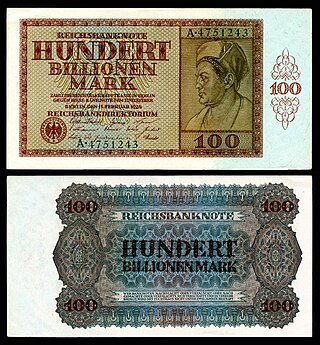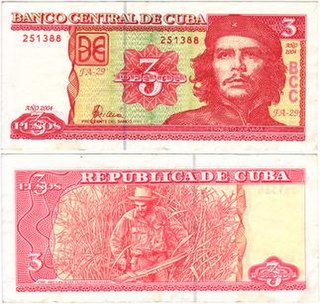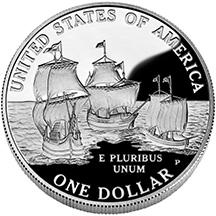
The Sri Lankan Rupee is the currency of Sri Lanka. It is subdivided into 100 cents, but cents are rarely seen in circulation due to its low value. It is issued by the Central Bank of Sri Lanka. The abbreviation Re (singular) and Rs (plural) is generally used, the World Bank suggests SL Rs as a fully disambiguating abbreviation for distinction from other currencies named "rupee".

The Papiermark was the German currency from 4 August 1914 when the link between the Goldmark and gold was abandoned, due to the outbreak of World War I. In particular, the Papiermark was the currency issued during the hyperinflation in Germany of 1922 and 1923.

The krone was the official currency of Austria-Hungary from 1892 until the dissolution of the empire in 1918. The subunit was one hundredth of the main unit, and was called a Heller in the Austrian and a fillér in the Hungarian part of the Empire.

The Cuban peso also known as moneda nacional, is the official currency of Cuba.

The Mohur is a gold coin that was formerly minted by several governments, including British India and some of the princely states which existed alongside it, the Mughal Empire, Maratha Empire, Kingdom of Nepal, and Persia. It was usually equivalent in value to fifteen silver rupees. It was last minted in British India in 1918, but some princely states continued to issue the coins until their accession to India after 1947. Similar coins were also issued by the British authorities in denominations of 2⁄3 mohur, 1⁄3 mohur and the double mohur, and some of the princely states issued half-mohur coins.

The Canadian five-cent coin, commonly called a nickel, is a coin worth five cents or one-twentieth of a Canadian dollar. It was patterned on the corresponding coin in the neighbouring United States. It became the smallest-valued coin in the currency upon the discontinuation of the penny in 2013.

The Iranian toman is a superunit of the official currency of Iran, the rial. One toman is equivalent to 10 (old), or 10,000 rials.
The Bermudian dollar is the official currency of the British Overseas Territory of Bermuda. It is subdivided into 100 cents. The Bermudian dollar is not normally traded outside Bermuda, and is pegged to the United States dollar at a one-to-one ratio. Both currencies circulate in Bermuda on an equal basis.

The Rupie was the currency of German East Africa between 1890 and 1916, continuing to circulate in the Tanganyika Territory until 1920.

The Bohemian and Moravian koruna, known as the Protectorate crown, was the currency of the Protectorate of Bohemia and Moravia between 1939 and 1945. It was subdivided into 100 haléřů.

The island of Alderney has its own currency, which by law must be pegged to that of the United Kingdom.
The peso was the currency of El Salvador between 1877 and 1919.

The dollar was the currency of the Raj of Sarawak from 1858 to 1953. It was subdivided into 100 cents. The dollar remained at par with the Straits dollar and its successor the Malayan dollar, the currency of Malaya and Singapore, from its introduction until both currencies were replaced by the Malaya and British Borneo dollar in 1953.
Commemorative banknotes of Costa Rica of the Costa Rican colón have been issued by the Central Bank of Costa Rica since its creation in 1950. The following is a list of the different issues printed on all the currently circulating notes along with a short description.
Commemorative coins of Costa Rica have been designed by the Central Bank of Costa Rica to celebrate special events. The following is a complete list of all commemorative coins issued by the BCCR.

In 2007, the United States Mint released a silver dollar commemorative coin which commemorates the 400th year after the founding of Jamestown. Surcharges from the sale of the Jamestown commemorative were donated to Jamestown-Yorktown Foundation of the Commonwealth of Virginia, the Secretary of the Interior and the Association for the Preservation of Virginia Antiquities to support programs that promote the understanding of the legacies of Jamestown.

The rigsdaler specie was a unit of silver currency used in Norway from 1544, renamed as the speciedaler in 1816 and used until 1873. Norway used a common reichsthaler currency system shared with Denmark, Hamburg and Schleswig-Holstein until 1873 when the gold standard was implemented in Scandinavia and the German Empire.
The Standard Catalog of World Coins is a series of numismatic catalogs, commonly known as the Krause catalogs. They are published by Krause Publications, a division of Active Interest Media.

The Prince Edward Island dollar was a unit of currency used in Prince Edward Island. The dollar replaced the Prince Edward Island pound in 1872 at a rate of 1 pound = 4.866 dollars. The dollar was subdivided into 100 cents.

Paolo Renier was a Venetian statesman, the 119th and penultimate Doge of Venice. He was a noted orator, and served as ambassador to the Ottoman Empire and to Austria. His election as Doge was unpopular, and he was the subject of numerous menacing letters at the time. Renier was succeeded as Doge by Ludovico Manin, who would be the last Doge of Venice. He married Giustina Donà in 1733, and Margherita Delmaz in 1751.













